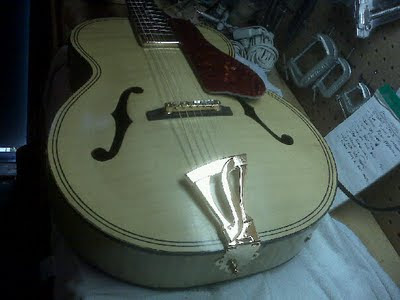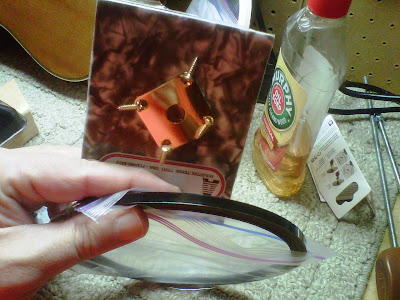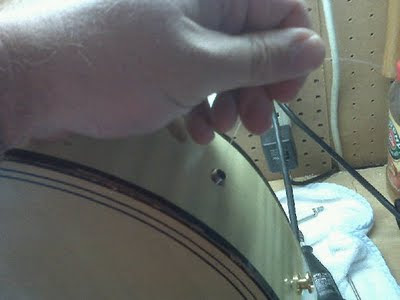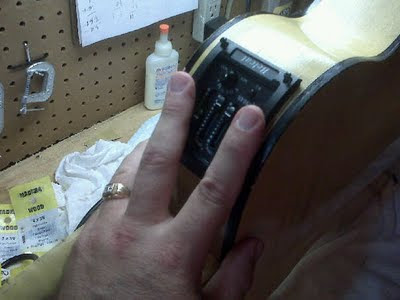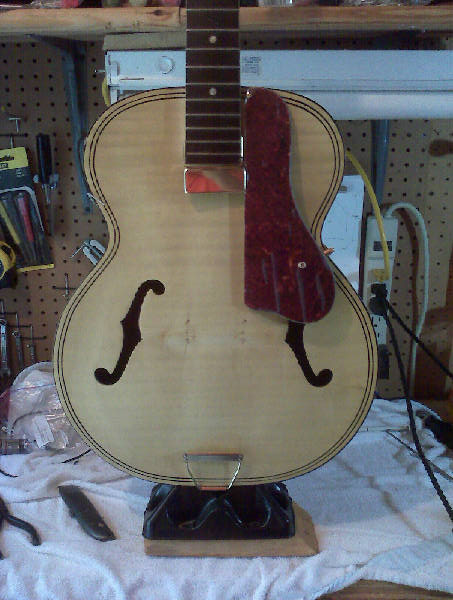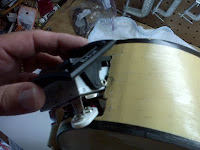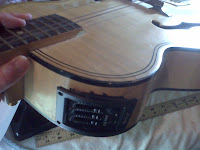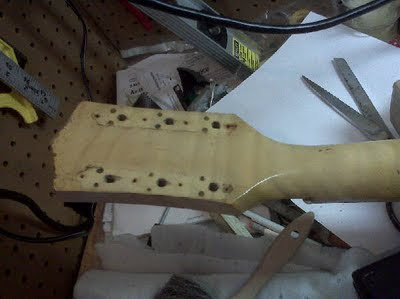One of the defining features of an archtop guitar is the tailpiece. If ever there was an opportunity to showcase an instrument, this is it! The one I had on my Holiday was way out of proportion; it just seemed too small for this old guitar. After making sure the electronics worked and setting the intonation at the bridge, it was time to do something about that tailpiece. After searching on eBay for a few days, I came across this one:
Back to the shed with my new tailpiece in hand, I marked up the holes to go into the end block. This tailpiece even covers up all of the old holes. After drilling the pilot holes and a few turns of a screw driver, I reattached the strings, and was pleased to find that the weight of this tailpiece was just right. Not only does it look right, she feels balanced with this heavier tailpiece.
After another bridge intonation adjustment, I plugged her in to my humble home recording studio and was pleased to find that the new tailpiece even added some sustain to this old guitar.
It has almost been a year since I've done any work on this guitar. The short scale length make it lots of fun to play, and it has a bright, clear tone. I've even made some amateur audio recordings with it, including a virtual multi-track jam with my friend Richard in New York.
Shortly after replacing the tailpiece, I started work on my current project, a 50-ish year old Harmony Sovereign. That's her in the upper-left corner of the picture below. While shopping for replacement parts for the Sovereign, I came across what should be the last of the parts I put on this Holiday: a set of Imperial-style gold tuning pegs, a gold "Les Paul" style jack plate and some black ABS binding. The Imperial-style tuning pegs are already on, and I put the gold Grover-style set on my Samick Dreadnought. Installing the new jack plate and binding on this old guitar are on hold for now, until I get to putting the replacement back binding on the Sovereign this summer or fall.
Like a fine wine, some musical instruments get better with age. Sometimes, due to age, neglect and abuse, older guitars needs some work and TLC to be returned to playable condition. This blog documents some of the work I have performed on musical instruments for myself and others over the years.
Tuesday, June 28, 2011
Wednesday, June 15, 2011
Holiday H1214 Archtop - Part II
With the new tailpiece in place, I moved back to the electronics. The pickup I chose is a vintage style closed-cover mini humbucker by Artec with a rated output of 7.6 k-ohms. Although there aren’t any individual pole adjustments on these pickup, the sound is managed onboard with a three-band Belcat EQ-9040 pre-amplifier. Keeping with the tradition of jazz boxes as rhythm instruments, one pickup in the neck position is all this guitar gets. Screws hold the pickup to the neck by way of an integral metal bracket that comes attached to the pickup.
My initial plan was to minimize the visual modifications to the guitar on this project. Although it would have been possible to run the pickup lead under the pickguard and through the treble-side Florentine hole to get to the preamp, that would have made for a very long lead with a spliced extension and a bunch of clips inside the guitar to keep the wire from rattling. Instead, I drilled a small hole through the top near the end of the fretboard. Fortunately, the installed pickup hides both the wire and the hole from plain sight.
Finding authentic replacement parts in usable condition for This Old Guitar turned out to be just plain impossible. The pickguard is a generic 4-ply laminated tortoise/mint/black/mint plastic made for archtop guitars of this size, and the mounting hardware is a new authentic Gibson ES 335 gold plated bracket kit. With the bracket attached to the existing hole in the body, the pre-drilled mounting hole in the pickguard mated up perfectly with the bracket location. I drilled a new hole at the narrow end of the pickguard to attach it near the neck/body joint, reusing the hole left from the original pickguard installation. A matching pair of new screws completed this part of the rebuild.
The idea of making another hole for the jack didn't sit well with me at first. The alternatives were to use an end-pin type or to attach something to the back of the pickguard. Neither of these options was particularly appealing to me. The end-pin option would make it necessary to always unplug or use a stand to put the guitar down, and it would be difficult to make any kind of rugged connection between the pickguard and an output jack. So, I opted for a through-the-side hole that would be fairly hidden. I figured I could come back to it and easily add a gold-plated Les Paul style mounting plate. Some fishing line came in handy for pulling the pre-wired jack through the new body hole.
The Belcat EQ-9040 preamp was intended for use with a flat top acoustic, and came with an under-bridge piezoelectric pickup. The preamp has two small jacks, a mini for the pickup input and a micro mini for the output. The preamp also comes with an output cable that’s ready for soldering to the output jack of your choice. Since I wasn’t using the piezo pickup, I soldered a new mini jack to the humbucker’s lead wire to make the connection to the preamp.
With all of the electronics hard-wired and plugged in, it was finally time to complete the preamp installation with four screws into the body!
Before bringing her to the inside of the house for a fresh set of D'Addario EJ15's, some bridge tuning and a test ride through an amplifier, I gave her one last cleanup with some Murphy's Oil Soap.
My initial plan was to minimize the visual modifications to the guitar on this project. Although it would have been possible to run the pickup lead under the pickguard and through the treble-side Florentine hole to get to the preamp, that would have made for a very long lead with a spliced extension and a bunch of clips inside the guitar to keep the wire from rattling. Instead, I drilled a small hole through the top near the end of the fretboard. Fortunately, the installed pickup hides both the wire and the hole from plain sight.
Finding authentic replacement parts in usable condition for This Old Guitar turned out to be just plain impossible. The pickguard is a generic 4-ply laminated tortoise/mint/black/mint plastic made for archtop guitars of this size, and the mounting hardware is a new authentic Gibson ES 335 gold plated bracket kit. With the bracket attached to the existing hole in the body, the pre-drilled mounting hole in the pickguard mated up perfectly with the bracket location. I drilled a new hole at the narrow end of the pickguard to attach it near the neck/body joint, reusing the hole left from the original pickguard installation. A matching pair of new screws completed this part of the rebuild.
The idea of making another hole for the jack didn't sit well with me at first. The alternatives were to use an end-pin type or to attach something to the back of the pickguard. Neither of these options was particularly appealing to me. The end-pin option would make it necessary to always unplug or use a stand to put the guitar down, and it would be difficult to make any kind of rugged connection between the pickguard and an output jack. So, I opted for a through-the-side hole that would be fairly hidden. I figured I could come back to it and easily add a gold-plated Les Paul style mounting plate. Some fishing line came in handy for pulling the pre-wired jack through the new body hole.
The Belcat EQ-9040 preamp was intended for use with a flat top acoustic, and came with an under-bridge piezoelectric pickup. The preamp has two small jacks, a mini for the pickup input and a micro mini for the output. The preamp also comes with an output cable that’s ready for soldering to the output jack of your choice. Since I wasn’t using the piezo pickup, I soldered a new mini jack to the humbucker’s lead wire to make the connection to the preamp.
With all of the electronics hard-wired and plugged in, it was finally time to complete the preamp installation with four screws into the body!
Before bringing her to the inside of the house for a fresh set of D'Addario EJ15's, some bridge tuning and a test ride through an amplifier, I gave her one last cleanup with some Murphy's Oil Soap.
Sunday, June 5, 2011
Holiday H1214 Archtop - Part I
This Old Guitar was in working condition when I found her. From the pictures the previous owner posted in his eBay ad, she appeared to be playable.
And, as promised, she was. The action was a bit high, but the neck was straight, so it was a good opportunity to switch out the stock wooden compensated bridge for one with a lower profile and individual string adjustments for intonation. The worst part was the damage to the upper bout, most likely caused by accident.
With my old ES335 in mind, I hit eBay and started the search for replacements parts and some goodies to electrify this Holiday. My vision was to make her into something electrified with minimal modification. So, I bought a pickup that could be mounted to the end of the fretboard and a set of volume and tone controls that could be attached to the replacement pickguard. That way, the modifications could even be reversed with very little effort.
The first thing to be done was to make a repair to that "extra" sound hole. My first attempt was to push out the damaged section with a curved block from the inside. I applied pressure by pulling with a wire from the outside that was attached to the block and threaded through the damaged area. The idea was that, with enough pressure, the damaged splinters would return to the shape of the curve. In practice, I quickly found out that I could not generate enough force to make the wood move. So, I moved on to widening the damage area enough to make a small rectangular wooden patch. The plan was to make a thick enough piece and glue it from the inside, and then add a piece of matching wood to cover the ugly mess.
Before the glue had dried, I was already trying to think of a better way to fix this mess. The next week, I was talking it over with a coworker that happens to be a fellow amateur musician and has done some work on his own guitars. His suggestion was to put a preamp in this spot, since it would be barely visible to anyone other than the person playing it. Genius! Except that the curvature of this guitar where the preamp would go was unlike any preamp module I had ever seen before. But, after a few months of searching at music stores and online, I finally found a candidate on eBay.

With the preamp chosen in hand, I cleared off the workbench in my shed and broke out some tools. I used my old battery powered Dremel with a drill bit to rough out the opening. The rest of the shaping was done with a drum sanding wheel attachment.

After getting the hole shaped, I thought it would be best to leave the final four-screw installation of the preamp into the old, brittle wood aside until I was ready to hook up the preamp and output jack.
Next, I removed the few strings that were holding the bridge in place, removed all of the hardware, and cleaned off her finish. It took a few applications of Murphy's Oil Soap, and when I got all of the grime and dirt off, she really started showing her age. Still, the faux zebra stripes do have a certain charm.

Next up was replacing the old tuners. The original 3-in-a-row opened-back pegs had ivory colored plastic buttons and no bushings. The sealed-back Grover knock-offs I found came with bushings, so I over-bored the peg holes to accommodate the larger shafts.
And, as promised, she was. The action was a bit high, but the neck was straight, so it was a good opportunity to switch out the stock wooden compensated bridge for one with a lower profile and individual string adjustments for intonation. The worst part was the damage to the upper bout, most likely caused by accident.
With my old ES335 in mind, I hit eBay and started the search for replacements parts and some goodies to electrify this Holiday. My vision was to make her into something electrified with minimal modification. So, I bought a pickup that could be mounted to the end of the fretboard and a set of volume and tone controls that could be attached to the replacement pickguard. That way, the modifications could even be reversed with very little effort.
The first thing to be done was to make a repair to that "extra" sound hole. My first attempt was to push out the damaged section with a curved block from the inside. I applied pressure by pulling with a wire from the outside that was attached to the block and threaded through the damaged area. The idea was that, with enough pressure, the damaged splinters would return to the shape of the curve. In practice, I quickly found out that I could not generate enough force to make the wood move. So, I moved on to widening the damage area enough to make a small rectangular wooden patch. The plan was to make a thick enough piece and glue it from the inside, and then add a piece of matching wood to cover the ugly mess.
Before the glue had dried, I was already trying to think of a better way to fix this mess. The next week, I was talking it over with a coworker that happens to be a fellow amateur musician and has done some work on his own guitars. His suggestion was to put a preamp in this spot, since it would be barely visible to anyone other than the person playing it. Genius! Except that the curvature of this guitar where the preamp would go was unlike any preamp module I had ever seen before. But, after a few months of searching at music stores and online, I finally found a candidate on eBay.

With the preamp chosen in hand, I cleared off the workbench in my shed and broke out some tools. I used my old battery powered Dremel with a drill bit to rough out the opening. The rest of the shaping was done with a drum sanding wheel attachment.

It was a tight fit with such a thin body, and I had to trim out some of the kerfing to give the battery swing enough clearance.
After getting the hole shaped, I thought it would be best to leave the final four-screw installation of the preamp into the old, brittle wood aside until I was ready to hook up the preamp and output jack.
Next, I removed the few strings that were holding the bridge in place, removed all of the hardware, and cleaned off her finish. It took a few applications of Murphy's Oil Soap, and when I got all of the grime and dirt off, she really started showing her age. Still, the faux zebra stripes do have a certain charm.

Next up was replacing the old tuners. The original 3-in-a-row opened-back pegs had ivory colored plastic buttons and no bushings. The sealed-back Grover knock-offs I found came with bushings, so I over-bored the peg holes to accommodate the larger shafts.
With the new pegs in place, I used some fishing line to locate the new tailpiece and check the height of the new bridge.
At one time, the centerline of the original bridge and tailpiece probably lined up well with the centerline of the body. But, that certainly was not happening now. You can see here that the tailpiece is about 3/8" off of the body centerline. The proper way to change the alignment of the neck meeting the body would be to do a neck reset, but it was close enough for me to leave it alone. On the other hand, the tailpiece I picked out looked so much better in the picture online than it did installed. Now, it looked too small and plain for this guitar, and the best patch I could possibly do to the original strap button hole would not be hidden in the least. I decided to leave the old strap button and tailpiece screw holes for the time being, until I decided what to do about the tailpiece.
Subscribe to:
Posts (Atom)
